Wednesday, June 26th 2002. Reading: Cosmic Perspective Chapters 19 and 20
In 1920 there was a famous public debate between Harlow Shapley and Herber Curtis about the nature of the spiral nebulae.
It was Shapley's contention that the spiral nebulae were within the Milky Way Galaxy and that the Milky Way Was the extent of the entire Universe.
Evidence:
Curtis argued that the spiral nebulae were actually star systems comparable to the Milky Way Galaxy and at great distances: Island Universes.
Evidence:
In order to settle the debate on the spiral nebulae direct determination of distances to them would be necessary.
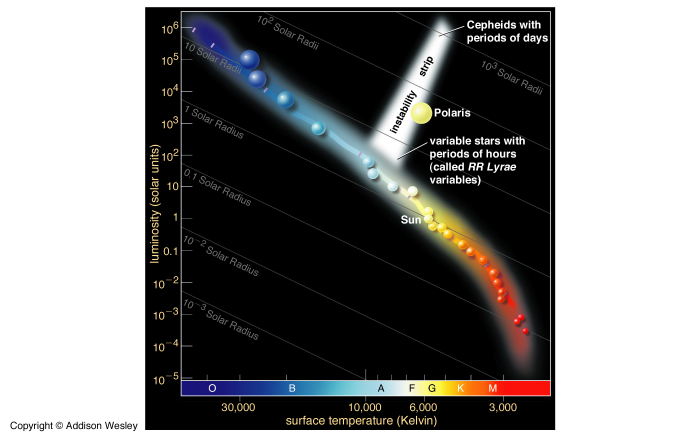 There are a kind of Red Giant Star whose visible surfaces pulsate with a regular period. These stars can pulsate in radius while they are on the So-called instability strip in the H-R Diagram.
There are a kind of Red Giant Star whose visible surfaces pulsate with a regular period. These stars can pulsate in radius while they are on the So-called instability strip in the H-R Diagram.
Low-Mass stars that pulsate while burning Helium in their cores are called RR Lyrae stars. High Mass stars that pulsate while burning several elements in multiple shells surrounding their cores are called Cepheid Variable stars. |
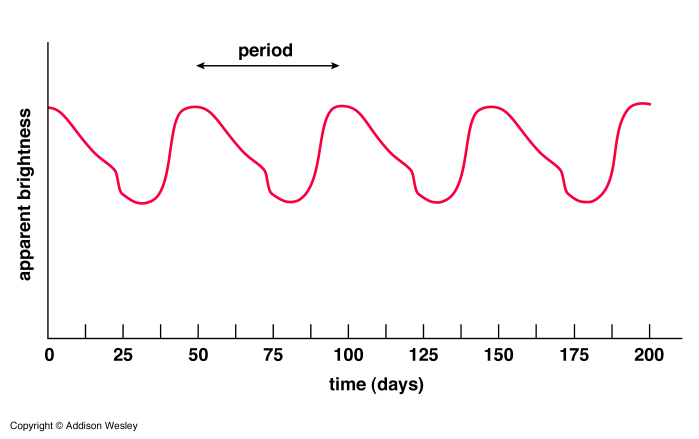 Pulstating stars change their Luminosity because their size is changing while the Temperature changes very little at the surface.
Pulstating stars change their Luminosity because their size is changing while the Temperature changes very little at the surface.
Bigger stars will have higher Luminosities and their period of pulsation is longer (they are bigger so it takes longer for their surfaces to rise and then fall back down). |
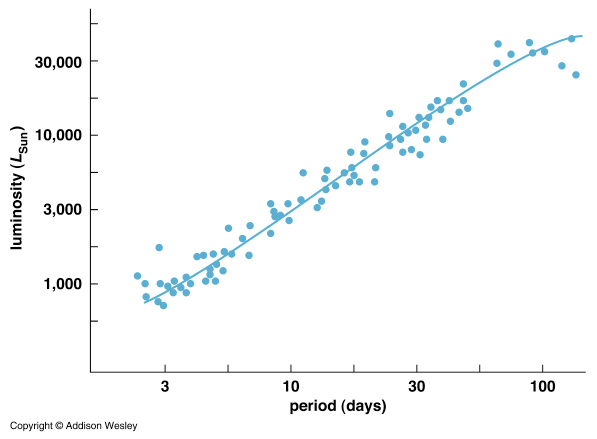 This leads to a relationship between the average Luminosity of the star and it's period of pulsation.
This leads to a relationship between the average Luminosity of the star and it's period of pulsation.
The Period-Luminosity relationship. If you observe the period of the star's variability then you can determine how Luminous the star is from this relationship. You measure the brightness of the star, and hence you can determine the distance. |
In 1924 American Astronomer Edwin Hubble made careful observations of Cephied variables in the spiral nebulae. He found that the Great Nebula in Andromeda was some 600 kpc distant, much greater than the size of the Milky Way Galaxy.
It was then proved that the spiral nebulae were actually galaxies in their own right, and the Universe suddenly became a very, very big place. The Andromeda Galaxy is our nearest spiral galaxy and its light takes 2.5 million years to reach us (the current value for the distance is 770 kpc).
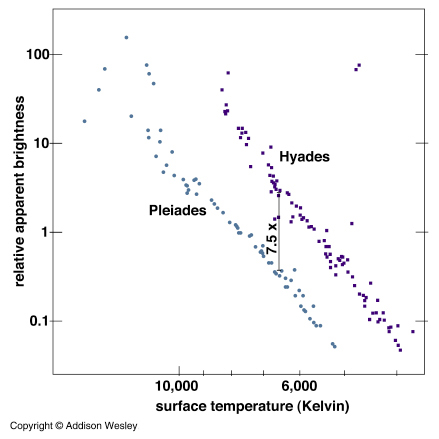 One method that is used to determine the distance to the LMC uses the Luminosities of Main Sequence stars within clusters. If you compare the main sequence of a cluster that is farther away than another, then the closer one will appear to be brighter.
One method that is used to determine the distance to the LMC uses the Luminosities of Main Sequence stars within clusters. If you compare the main sequence of a cluster that is farther away than another, then the closer one will appear to be brighter.
Example: The main sequence of the Pleiades Cluster is 7.5 times fainter than that of the Hyades cluster. Since we assume that the stars at the same points in the Main Sequences have the same luminosities this means that the Pleiades if farther away. The distance to the Hyades is known via Parallax to be 46.3 pc. bHyades/bPleiades = 7.5 = d2Pleiades/d2Hyades dPleiades = 126.8 pc |
Distances to galaxies are difficult to determine once they are so far away that Cepheid variables or any individual stars cannot be resolved. There have been some relations empirically discovered between the velocities in a galaxy and its luminosity.
It is found that L ![]() v4 for galaxies, where v is a velocity measurement. This is called the Tully-Fisher Relationship. How v is measured differs for spiral and elliptical galaxies. So if the luminosity of an entire galaxy is inferred and a brighness measured, again we can find a distance.
v4 for galaxies, where v is a velocity measurement. This is called the Tully-Fisher Relationship. How v is measured differs for spiral and elliptical galaxies. So if the luminosity of an entire galaxy is inferred and a brighness measured, again we can find a distance.
There are indeed many other ways to determine distances, but most all use the idea of a "standard candle", i.e. something that you believe you know how how luminous it is and you can determine its distance by measuring its brightness. Examples: White Dwarf Supernovae, Planetary Nebulae and Globular Clusters distributions, The Tip of the Red Giant Branch, Surface Brightness Fluctuations.
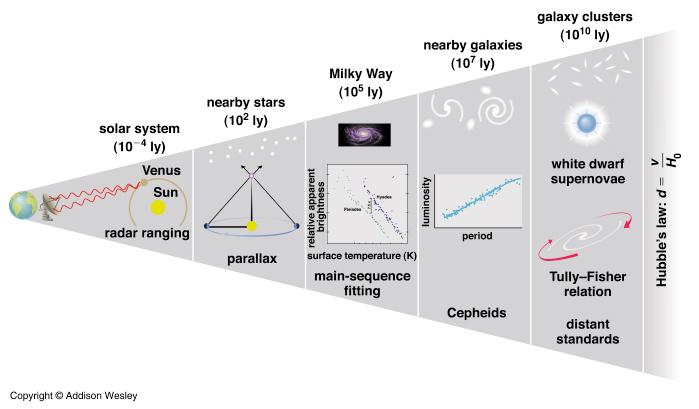

These types from Sa - Sc form a sequence of
Disks are where most of the star formation is taking place (as indicated by the O stars and the emission nebulae).
All of the regions between the spiral arms contain stars, not just the spiral arms themselves. Stars with high abundances of metals are found in the disk, indicating that they are at least second generation stars and likely third or more.
The bulges contain little gas (except often near the nucleus) and relatively old stars.
The halos contain few enough stars that they are not easily seen in images. The bulges and haloes contain stars with few metals which are likely first generation stars that are quite old.
Elliptical Galaxies:
These galaxies are classified E0 - E7 and their classification depends on their apparent axis ratio.
Elliptical galaxies compared to spirals
Lenticular galaxies:
S0 galaxies - these are intermediate between ellipticals and
spirals - they have featureless disks and bulges, but no spiral arms
and little gas and dust, like ellipticals.
Irregular and Peculiar galaxies:
Irregular galaxies: e.g., Large Magellanic Cloud, lots of dust and gas
Peculiar galaxies: usually a spiral or elliptical with a weird shape.
The Local Group
Contents of the Local Group
This suggests that dwarf galaxies may be the most common galaxies in the universe. They are too faint to be seen very far away.
Other nearby groups: M81 - M82 Group
Clustering of Galaxies
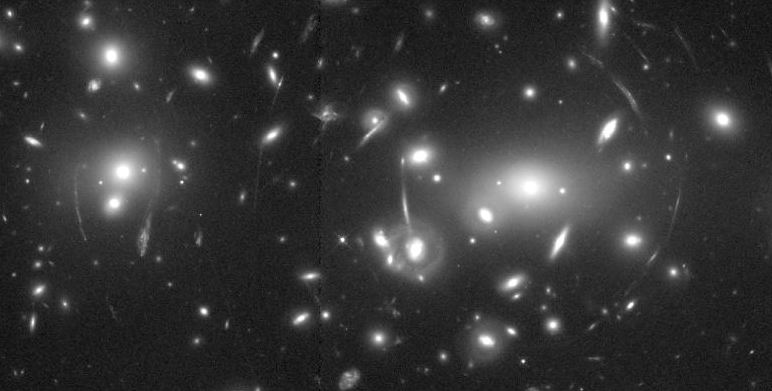 Galaxies tend to occur in clusters
Galaxies tend to occur in clustersTypes of clusters
|
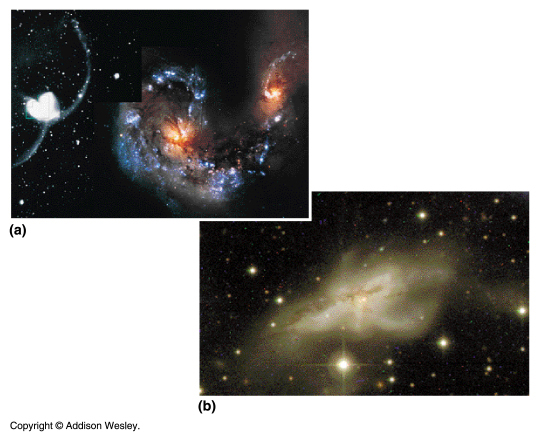 Galaxies are often seen to be gravitaionally interacting with one another if not directly colliding and merging. Just recently a dwarf elliptal galaxy, called the Saggitarius Dwarf, has been discovered that is currently being absorbed by our own Milky Way Galaxy.
Galaxies are often seen to be gravitaionally interacting with one another if not directly colliding and merging. Just recently a dwarf elliptal galaxy, called the Saggitarius Dwarf, has been discovered that is currently being absorbed by our own Milky Way Galaxy.
It is likely that the SMC and LMC will some day be absorbed by the Milky Way. They show evidence that they have already made close passes to the Galaxy and have been tidally disrupted. Their odd shapes are a testament to their recent encounters with the Milky Way. |
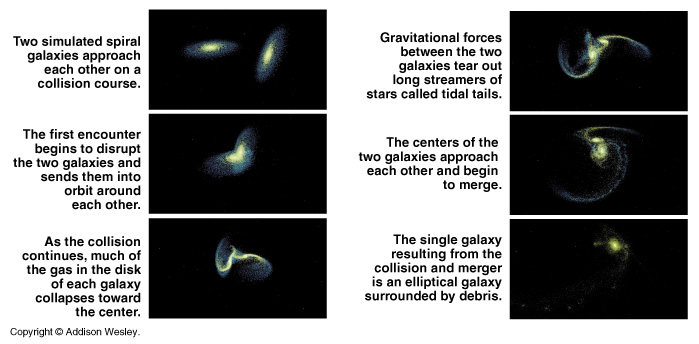 In about 5 billion years the Andromeda Galaxy and the Milky Way Galaxy will collide or at least make a close enough pass of one another to cause severe tidal disruptions in both galaxies. In other such collisions observed in the Universe we see large tails of material stripped out from colliding galaxies.
In about 5 billion years the Andromeda Galaxy and the Milky Way Galaxy will collide or at least make a close enough pass of one another to cause severe tidal disruptions in both galaxies. In other such collisions observed in the Universe we see large tails of material stripped out from colliding galaxies.
Giant elliptical galaxies in the centers of clusters have likely gotten so large by assimilating their neighbors.
|
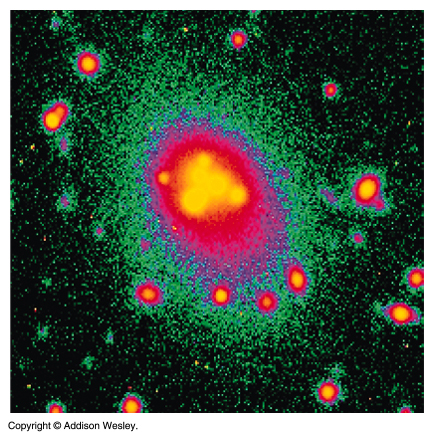 These collisions are not detructive at all. In fact, the distances between stars are so immense that direct stellar collisions almost never happen, except for perhaps in the much more dense galactic nuclei. The collisions of spiral galaxies with a lot of gas and dust often lead to increased star formation. The colliding gas shocks and collpases under gravity and in a very short time forms many, many more stars than normal. Such an event is called a starburst, and these galaxies are sometimes called starburst galaxies.
These collisions are not detructive at all. In fact, the distances between stars are so immense that direct stellar collisions almost never happen, except for perhaps in the much more dense galactic nuclei. The collisions of spiral galaxies with a lot of gas and dust often lead to increased star formation. The colliding gas shocks and collpases under gravity and in a very short time forms many, many more stars than normal. Such an event is called a starburst, and these galaxies are sometimes called starburst galaxies.
|
 If we look to farther and farther distances we see further back in time. Thus we can look at how galaxies evolve in time.
If we look to farther and farther distances we see further back in time. Thus we can look at how galaxies evolve in time.
Preliminary results using the Keck and Hubble telescopes:
|
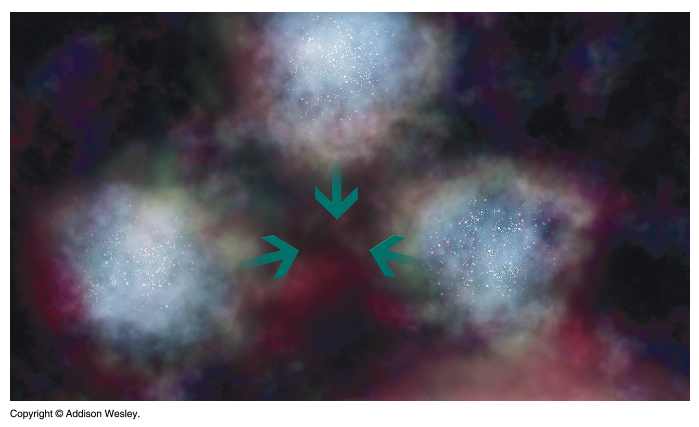 The current best hypothesis right now for galaxy formation is that galaxies form from gigantic gas clouds in the early Universe that are slightly overdense from the average. The giant clouds collapse under gravity and begin forming stars right away.
The current best hypothesis right now for galaxy formation is that galaxies form from gigantic gas clouds in the early Universe that are slightly overdense from the average. The giant clouds collapse under gravity and begin forming stars right away.
Smaller clouds run into each other and merge, building up larger and larger galaxies. |
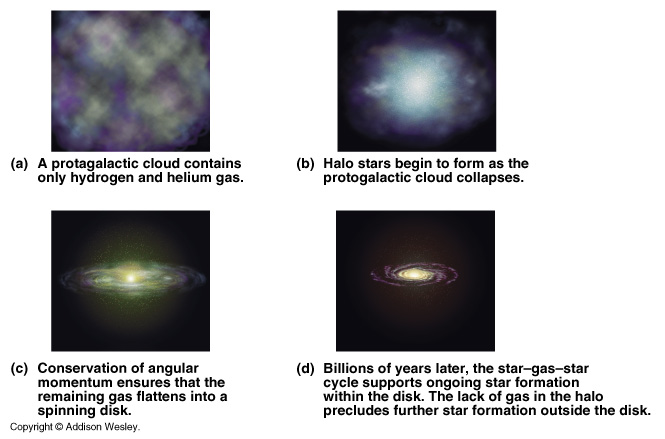
|
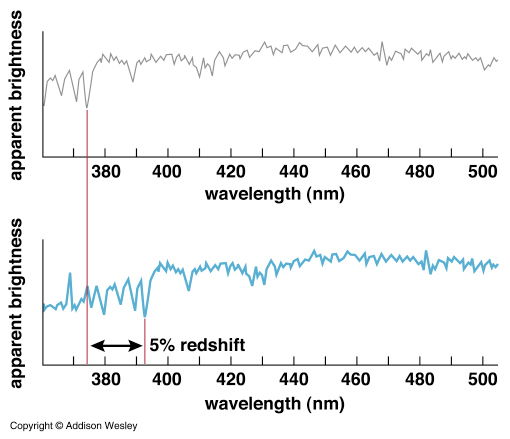
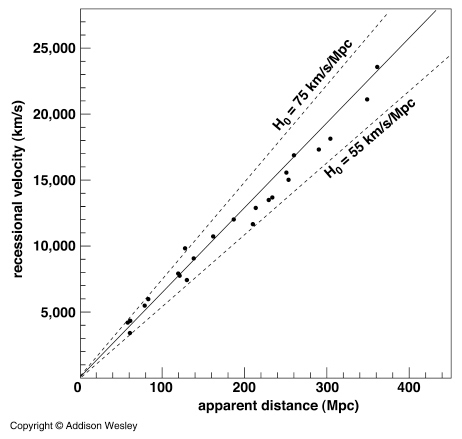 In 1929, Edwin Hubble, using the period-luminosity
law for the Cepheid variables (discovered by Harvard Astronomer Henrietta Leavitt), was able to make a plot of the
velocity of a galaxy (determined by the doppler shift of its spectral
lines) plotted against distance.
This plot showed that the more distant a galaxy is, on average,
the faster it moves away from the Milky Way.
In 1929, Edwin Hubble, using the period-luminosity
law for the Cepheid variables (discovered by Harvard Astronomer Henrietta Leavitt), was able to make a plot of the
velocity of a galaxy (determined by the doppler shift of its spectral
lines) plotted against distance.
This plot showed that the more distant a galaxy is, on average,
the faster it moves away from the Milky Way.
Hubble's Law: Where Ho (H-nought) is known as the Hubble constant (now; it changes with time) and the modern value is about 65 km/s per Mpc, or 65 +/- 15 km/s/Mpc . |
|
Redshift: z =
z = v/c --> v = cz = 3x105km/s * 0.003 = 900 km/s
All galaxies are moving away from us. The Universe is EXPANDING!!! |
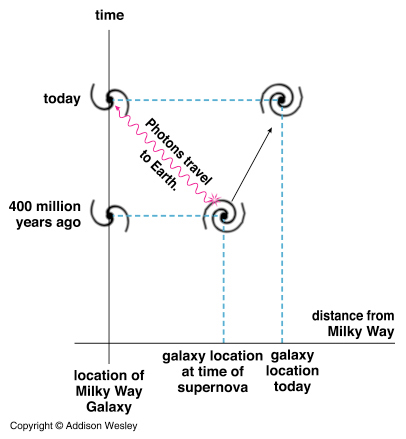 Imagine an "infinite raisin cake" expanding uniformly. As the dough rises (expands) the raisins move away from each-other. The raisins farther away from you move a greater distance away than do the raisins near you in any given time period. Thus, they must be moving away from you faster than the ones nearby.
Imagine an "infinite raisin cake" expanding uniformly. As the dough rises (expands) the raisins move away from each-other. The raisins farther away from you move a greater distance away than do the raisins near you in any given time period. Thus, they must be moving away from you faster than the ones nearby.
A 2-D example is the surface of a spherical balloon, or a Hoberman Sphere. |
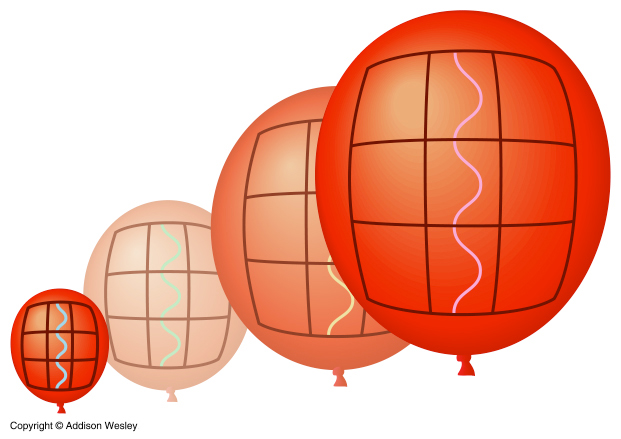 As the Universe Expands the space between the crests of light also expands and so the light appears to become redshifted.
As the Universe Expands the space between the crests of light also expands and so the light appears to become redshifted.
The galaxies are not actually moving through space. The redshift we see is not a Doppler Shift. The redshift is due to the expansion of space itself. Thus we call it a Cosmological Redshift. |
Why do we think this is so? Occam's Razor. It's a simpler Universe than one designed such that everything races away from us. (there is also plenty of observational evidence to support it, but we'll talk about that next week.)
The Final step in the Copernican Revolution: we are not the center of the Universe, there is no center of the Universe.
Distance
Measuring distances accurately is very difficult. Measuring redshifts is actually pretty easy, however.
Obtain distances and redshifts of many galaxies, at different distances --> determine Ho. Then, use Ho to deduce distances of extremely distant galaxies and quasars.
Problem: must account for deviations from the "Hubble Flow" (uniform expansion) to determine Ho. (e.g. the Local Group is "falling into" the Virgo Cluster). Peculiar Velocity, vp = cz - Hod. At larger distances the Hubble Flow dominates the redshift.
NOTE: v = Hod does NOT imply that the speed of a galaxy increases with time. In simple models of the Universe H ![]() 1/t. So, the speed of a given galaxy decreases with time (or at best remains constant). Hubble's constant is a constant in space not in time.
1/t. So, the speed of a given galaxy decreases with time (or at best remains constant). Hubble's constant is a constant in space not in time.
ALSO: Space between clusters (or superclusters) expands. Clusters, galaxies, stars, planets, people, DO NOT. Gravity (or electromagnetic and/or nuclear forces) holds them together.
Thus, properly speaking, it is the scale of the Universe that is expanding.
Return to Class Notes Page